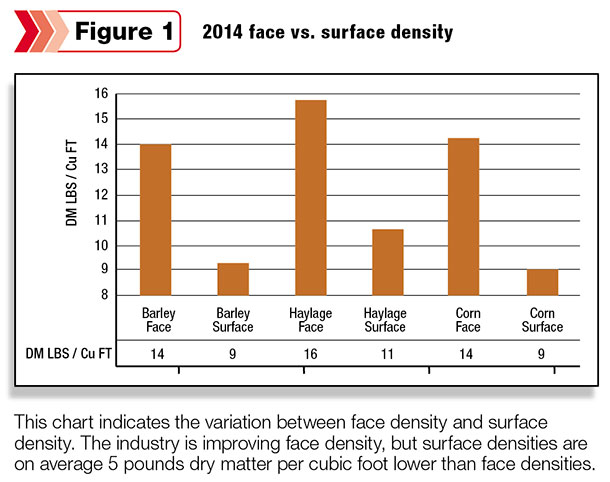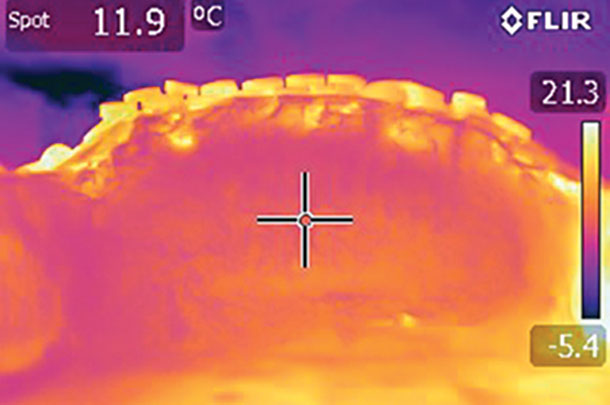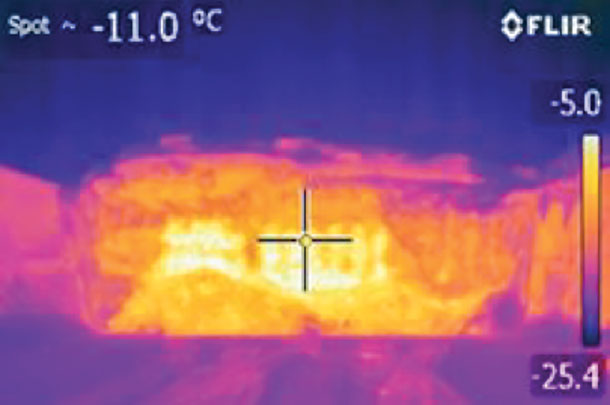In 2014, Nutri-Source conducted a silage management audit of 170 barley, corn and haylage silage piles and bags. Samples were collected from the faces of bags or pits to determine dry matter pounds per cubic foot.

Surface densities were also collected by coring down into the surface of the pit or pile up to 5 feet. The study indicated face densities are getting closer to meeting industry goals, due largely to the fact that equipment can operate within these areas as the pit or pile is being built and more packing weight has been added to packing equipment.
However, surface densities were on average 5 pounds dry matter per cubic foot lower than face densities. This is not surprising as the surface, or part of the pile elevated above the sides of a typical bunker, is difficult to pack due to the ability of packing equipment to operate safely and a reduction of surface to pack against (no sides on the pit at the pile’s peak). Thus, the surface is most at risk for secondary fermentation.
Secondary fermentation
Secondary fermentation, as its name suggests, is when fermentation takes place after the primary fermentation. Fermentation is achieved by packing forage tightly to exclude oxygen. In this process, the pH of the silage will drop out of a range that molds and yeasts can grow and multiply, and dry matter (DM) loss is minimal.
When oxygen is reintroduced to silage after it has fermented initially, molds and yeasts will be produced and DM loss will occur. This has a significant impact on feed quality and economics.
With the reduction shown in densities in at least the top 5 feet of pits or piles, we can expect that there is a greater risk of secondary fermentation in this area. Lower densities allow oxygen to penetrate deeper into the surface of the pile, creating heating and secondary fermentation.
Over the last two years, it has been determined higher temperatures are experienced in the top third of pits and piles. Photo 1 shows a pit covered with black-and-white plastic and tires.

Due to the shape of the pit, it proves difficult and unsafe to pack the top 6 feet of the pit properly, and there is no surface to pack against. As a result, we can see spoilage at the top 4 to 6 feet of this pit.
Research has shown that in a squared meter of black-and-white silage plastic, 2 liters’ worth of oxygen will penetrate through the plastic within a 24-hour period. This is a significant impact over a large pit or pile.
For years, using one sheet of standard black-and-white plastic has been an acceptable management practice. With the development of new research, many are moving toward utilizing oxygen-barrier plastics. These products greatly reduce the oxygen transfer rate through the plastic and help reduce secondary fermentation.
Keys to reducing secondary fermentation in the top third of pits and piles:
- Add more consistent packing weight when building pits or piles. This will increase the whole density of your pit or pile and reflect positively on the top third.
- Higher densities will speed up the fermentation process and create aerobic stability.
- Manage plastic, tire or gravel bags.
- Ensure the plastic is cut at the face to prevent wind from blowing back under the plastic cover.
- Utilize tires to prevent oxygen from penetrating under the plastic and to secure the cover to the pit or pile.
- Monitor plastic for holes.
- Use protective nets to protect plastic if birds or wildlife are an issue.
- Cover with plastic, tires and gravel bags as soon as possible after filling. This will reduce the time silage is exposed to the environment and speed up fermentation.
Face management
The face is a high-risk area due to constant oxygen exposure and the seasonal environment. Photo 2 illustrates a pit experiencing a significant amount of heating even in winter months.

This face has been disturbed aggressively with a loader during feedout, which reduces densities and allows oxygen to penetrate the face, creating aerobic instability.
On the bottom of the face is a large amount of loose feed that is also heating. In this situation, the loose feed and the face will sit for 24 hours exposed to oxygen and the seasonal environment.
Eliminating loose feed will help achieve the following:
- Keep silage fresh and palatable
- Loose feed exposed to oxygen will create secondary fermentation that will affect pH and digestibility.
- Lower constant temperature
- Help reduce DM changes
- Rain, snow and heat will affect the DM more dramatically in loose feed compared to the face.
Tools to improve silage quality
-
Silage defacers and block cutters – These tools help reduce loose feed and density disturbance. These two key benefits reflect positively on aerobic stability of the face, preventing secondary fermentation and inconsistencies.
-
Packing equipment and weights – Adding weights on packing equipment will promote higher densities. Many producers and custom-choppers have been adding more and more weight to packing tractors.
This includes suitcase weights, adding fluid to tires and three-point hitch weights. It is recommended to distribute silage while packing in thin, even layers to improve densities.
-
Inoculant – Inoculants are tools used to greatly improve the fermentation speed of your silage. Improving fermentation speed will reduce the pH to a range where molds and yeasts cannot survive and multiply.
Silage that does not have inoculant applied has a longer period of time for mold and yeast to grow and multiply. This will increase dry matter loss in the silage and elevate spoilage in high-risk areas such as the surface and the face of the pit or pile.
- Oxygen-barrier films – As noted earlier, not all silage plastics are effective oxygen barriers designed to reduce secondary fermentation in the top third of pits and piles. A good cover will cling to silage to eliminate air pockets and prevent oxygen from penetrating the surface.
Summary
Densities have significant impacts on DM retention and silage quality. Management during chopping and packing will have a tremendous impact on the aerobic stability and dry matter retention within your silage inventory.
Day-to-day face management will reduce secondary fermentation and elevate the consistency of nutrition delivered to livestock. And, as always, be safe when harvesting, packing and feeding. FG

-
Georges Uebelhardt
- Dairy Management Consultant
- Nutri-Source Inc.
- Email Georges Uebelhardt









